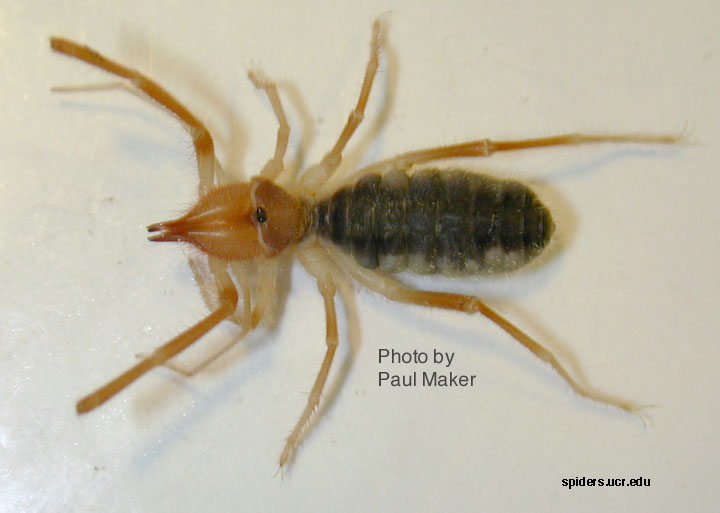Camel Spiders: Facts & Myths

Large, tan, hairy, and ferocious-looking, the camel spider is the stuff of legend — urban legend, that is. While these creatures are undoubtedly large, they are by no means half the size of a human and in the habit of dining on camel stomachs and sleeping soldiers.
“Camel spiders, which are arachnids, but not spiders, are definitely unique little critters,” said entomologist Christy Bills, invertebrate collections manager at the Utah Museum of Natural History.“Unfortunately, some people assign them fierce characteristics because of their appearance. They do not disembowel camels, jump in the air nor run after humans. … In captivity, they are quite the divas and require princess-like accommodations to be kept alive.”
Classification/taxonomy
Camel spiders belong to the class Arachnida, but while all spiders are arachnids, not all arachnids are spiders. Another common name is wind scorpion, but it’s not a scorpion, either. The camel spider is of the order Solifugae, which is Latin for “those who flee from the sun,” according to the National Science Foundation (NSF). There are more than 150 genera and more than 1,000 species of solifuges, according to the Integrated Taxonomic Information System (ITIS). The taxonomy of camel spiders is:
- Kingdom: Animalia
- Subkingdom: Bilateria
- Infrakingdom: Protostomia
- Superphylum: Ecdysozoa
- Phylum: Arthropoda
- Subphylum: Chelicerata
- Class: Arachnida
- Order: Solifugae
- Families: Ammotrechidae, Ceromidae, Daesiidae, Eremobatidae, Galeodidae, Gylippidae, Hexisopodidae, Karschiidae, Melanoblossiidae, Mummuciidae, Rhagodidae, Solpugidae
Appearance & habits
According to the BBC, though camel spiders appear to have 10 legs, they actually have eight. The two extra leg-like appendages are sensory organs called pedipalps. Camel spiders can reach up to 6 inches (15 cm) in length and weigh about 2 ounces (56 grams).
“Their heads come to a point, which is interesting,”Bills said. “It’s where their chelicerae meet.” Chelicerae are essentially jaws, used to catch prey. According to National Geographic, these jaws can be up to one-third of a camel spider’s body length. “When they eat, their chelicerae move against each other in a fascinating way” Bills continued.
While most commonly found in Middle Eastern deserts, camel spiders also live in the southwestern United States and Mexico, according to the NSF. Camel spiders are primarily nocturnal and flee from the sun.
Camel spiders are carnivores. According to Camelspiders.org, they eat other bugs, lizards, small birds and rodents. Despite their reputation and frightening appearance, they are of negligible threat to humans.
Get the world’s most fascinating discoveries delivered straight to your inbox.
“They aren’t even venomous,” Bills said. Their jaws are their primary weapon. After seizing a victim, they turn it to pulp by chopping or sawing the bodies with their jaws. According to National Geographic, camel spiders “utilize digestive fluids to liquefy their victims' flesh, making it easy to suck the remains into their stomachs.”
“They are fast runners and adapted to desert living,” Bills said. They can run up to 10 miles per hour. Unlike spiders, camel spiders breathe with a trachea, which allows for fast oxygen intake and helps them move quickly.
Camel spider myths
The camel spider first gained notoriety in the West during the Gulf War in the early 1990s, according to National Geographic. Their fame only grew when the United States invaded Iraq in 2003. Then, they became an Internet sensation. Forced-perspective photographs made the spiders look as big as a human leg, when in reality, “Even where they are very large, in the Middle East, they could be easily squished under a person’s shoe,” said Bills.
Though the camel spider became infamous in the West relatively recently, it has long been the stuff of legend in the Middle East. Some common myths about it are:
Camel spiders run after humans: Camel spiders don’t want you; they want your shade. According to the NSF, when a person runs, the camel spider will chase the shadow. If a person stands still, the camel spider will, too, enjoying the cool. Though camel spiders seek to avoid the sun during the day, they are attracted to light at night, and will run toward it.
Camel spiders scream: Some species may hiss as a defensive behavior, but the majority make no sound.
While under a camel, they leap into the air and disembowel it, eating its stomach: While untrue, this old myth probably gave the camel spider its name, according to Snopes.com. Camel spiders may stand under camels for the shade.
Camel spiders eat or chew on people while they sleep. Their venom numbs the area so people can’t feel the bites: Camel spiders are not venomous, and though their bites are painful, they are not deadly to humans, according to NSF.
Camel spiders can run up to 30 mph (48 kph) and jump up to 3 feet (1 meter) high: The fastest camel spider clocks in about 10 mph (16 kph). They don’t do any significant jumping.
Editor’s Note: If you’d like more information on this topic, we recommend the following book:
Additional resources
- National Geographic: Egyptian Giant Solpugid (Camel Spider)
- Fred Punzo, "The Biology of Camel-Spiders: Arachnida, Solifugae" (Springer, 1998)
- Burke Museum of Natural History and Culture: Spider Myths
Jessie Szalay is a contributing writer to FSR Magazine. Prior to writing for Live Science, she was an editor at Living Social. She holds an MFA in nonfiction writing from George Mason University and a bachelor's degree in sociology from Kenyon College.


